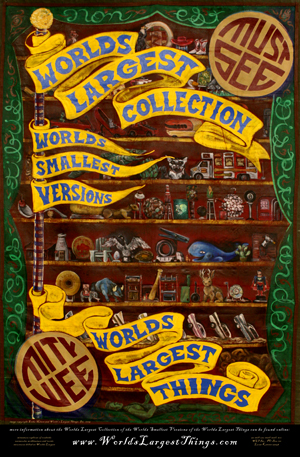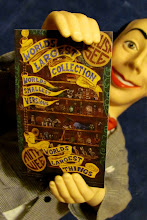Erika Nelson should be an Iowan. She would fit right in with our taste for the large and oddball, which she will speak of today at Iowa State University in Ames.
Nelson, of Lucas, Kan., gathers stories and photographs of the nation's largest roadside attractions, every large ceramic bullhead and ball of twine, every giant popcorn ball and ketchup bottle.
Then, she makes small replicas of the attractions to put in a mobile museum called the World's Largest Collection of the World's Smallest Versions of the World's Largest Traveling Roadside Attraction and Museum.
About 10 years ago, Nelson began her quest for the unusual because everything started looking the same across America. With interstate travel, the roadside monuments had grown few and far between, so she decided to catalog them.
"I really like the Iowa monuments - Albert the Bull in Audubon, the popcorn ball in Sac City," said Nelson, director of the World's Largest Things, a nonprofit organization in Lucas.
Iowa has 15 attractions on her list on www.worldslargest things.com, including the giant strawberry in Strawberry Point, the colossal bullhead in Crystal Lake - erroneously listed as a catfish on her Web site - and the 25-foot Pocahontas in Pocahontas.
In 2002, Nelson dived headlong into the task as a full-time job, traveling to every state. She found the stories were even more interesting than the monuments, such as the gigantic cow hair ball in Kansas and the humongous clothespin in Philly.
One of the most poignant stories, she said, is the world's largest penny in Woodruff, Wis.
A local doctor in the 1930s decided the town needed a hospital. Everyone told the doctor she was nuts, the town was too small. So she asked the kids to help her with a million-penny march.
The kids' million pennies launched the building of a hospital still operating today.
So residents built a giant cement penny.
Iowa has a big story, as well.
In Sac City, residents built the World's Largest Popcorn Ball in 1995 to recognize the significance of corn as a crop. It was so popular, they hauled it to the Iowa State Fair. Travelers constantly wanted to see it, which grew tiresome.
So they had a grownup-kid idea: Let's blow it up and see what happens.
Seven sticks of dynamite were inserted into the ball, a crowd gathered and - poof! - the ball's sticky goo smothered the explosion. It rather gently broke apart.
By 2004, Sac City residents missed the giant ball and decided to build an even bigger one - 3,100 pounds - and house it indoors.
A resurgence of interest in Route 66 and other secondary roads is led by people who were once the kids in the backseat and who are now trying to save what they saw.
Many have disappeared, including the world's largest cedar bucket in Murfreesboro, Tenn.
Yet new ones pop up every day, as Internet users catch on to the blog on her Web site and suggest roadside attractions.
What does it all mean? What is the greater significance of the world's largest cow skull in Arizona and the biggest chili can in Beloit, Wis.?
"Once you tell people the story behind the monuments, they begin to understand the community which built them," Nelson said.
"Also, the monuments show the American spirit - that defiance.
"I think it's a young-country thing. Canada and Australia also have a lot of these kitschy structures. We are somehow trying to make up for the fact we don't have the same history as our ancestors. But we know how to build a really big chicken."
Reporter Mike Kilen can be reached at (515) 284-8361 or mkilen@dmreg.com
Here's the link to the actual article, with pics:
Des Moines Register "Kansas goes on the road for Quirky"
Subscribe to:
Post Comments (Atom)






No comments:
Post a Comment